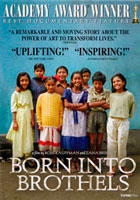 Director: Zana Briski
Director: Zana Briski
Duration: 83 minutes
Year: 2004
Key words: Poverty, child labour, child neglect, commercial sex work, education, domestic violence, drug abuse, overcrowding, slums, advocacy
Summary: Director Zana Briski goes to India to make a documentary about sex workers but while there is struck by the way their children live with them in the brothel. She begins teaching the children about photography and advocating for them.
Degree of public health theme coverage: The main public health theme in this documentary is around poverty and child neglect. Specific aspects relating to health include: long hours of child labour, lack of proper child education, physical and verbal violence against children, crowded housing, parental drug use, illicit alcohol, references to parental suicide, homicide of sex workers, and irrational rules imposed by authorities (such as HIV testing of children before school acceptance). There is also child labour and neglect. One of the young girls works as a maid for someone else living in the brothel. She must do house work and cooking whenever requested, up until 11pm at night. Another girl's father and grandmother tried to sell her but her sister rescued her. All the girls fear that soon they will need to become sex workers and are often under pressure from their families to do this. Pictures show children in leg chains (presumably as a restraint strategy) and the children are forced to play on roof tops (when their mothers are working as sex workers). Education is presented as the way out of this situation for all the children but it is very difficult for sex workers' children to enrol in schools.
The damaging effect of drug addiction on families is shown. One boy's father is a heavy user of hash (cannabis). His use has meant that his wife (the child's mother) left him, his children must work and that he does not actively parent but must instead be looked after.
The cycle of poverty and dependence on commercial sex is apparent. People are poor therefore resort to commercial sex to earn money. However it is then difficult for their children to get into schools meaning they too must go into the sex industry. Children saw no solution to this. Zana, the director of the movie, saw them as doomed without interventions (such as proper schooling).
There is the stigmatisation of sex work. It is illegal therefore the children's parents are seen as criminals. This means their children get little access to schooling and the sex workers themselves are left vulnerable to physical attacks with no recourse to seek help from the police. Eg, a “Kitchen accident” that is actually a homicide carried out by the pimp of one of the mothers – results in no police involvement. There are also administrative barriers for the children eg, to attend school a number of forms need to be completed, including a medical certificate with a HIV test and ration card. Score=3/5
Sophistication of analysis of public health content: The movie explores many facets of the children's lives. In particular it explores the multitude of effects their parent's sex work have on the children (along with poverty, crowded living conditions, domestic violence, parental drug use etc). There are glimpses of the wide societal issues eg, the crowded nature of a large Indian city, the illegality of sex workers lives (commercial sex, drug dealing and illicit alcohol sales), the inefficient nature of the bureaucracy etc. But none of the macro-solutions are dealt with (eg, economic reforms in India, population control in India, decriminalising commercial sex, providing proper schooling for all children through state-run systems). Score=2/5
Potential for empowerment and use of advocacy: Zana (the movie director) teaches the children photography and then organises to have their photographs featured in the Amnesty International calendar (and at an Exhibition in Amsterdam). The prints are sold in New York to help pay for the children's education. This process suggests the potential power of photography for advocacy purposes. Zana arranges for all of the children to be given the opportunity to attend good schools (which appears to succeed for some and not for others). The highly idiosyncratic nature of this project (one enthusiastic and well-resourced photographer) makes one wonder about the generalisability of the approach. It is really about advocacy around the problem and not changing the systems in India that perpetuate exploitation, child neglect and poverty in the red light district.Score=3/5
Persuasiveness of the movie: The documentary nature makes the movie seem very real. The failures and successes are both dealt with in what seems a genuine way. The general format is that we hear a child's story and then see the pictures they have taken.
The description of the problems seems fairly convincing as Zana, the movie director, often speaks candidly to the camera regarding successes but also her frustrations with the red tape involved in each step of trying to secure proper schooling for the children. Score=3/5
Engagement and cinematic quality: The movie is engaging and there is a sense of really seeing into these children's lives and living conditions. The children's photographs are well done. Score=3/5
Total score = 14/25
Questions for discussion:
- Do you agree with what this movie maker did in this situation?
- Is this type of intervention a sustainable approach to lifting these children out of poverty?
- What might be the fundamental solutions to the poverty and exploitation in this red light district in a developing country?
Other information:
- There is a Wikipedia article on this movie - found here
- The trailer can be seen on YouTube - found here
- Back to Films in Undergraduate Public Health Teaching home page
CONTACT US
Associate Professor Nick Wilson
Department of Public Health
University of Otago, Wellington
PO Box 7343
Wellington South 6242
New Zealand
Tel: +64 4 385 5541 ext 6469
Fax: +64 4 389 5319
Email: nick.wilson@otago.ac.nz